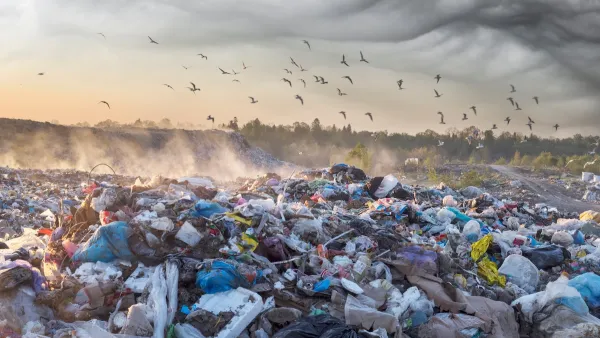According to to a recent study, methane gas produces a much larger greenhouse effect than previously thought. Planners can act to limit the environmental impact of methane.

New Research Directly Measures Methane's Increasing Greenhouse Effect
Greenhouse gases absorb specific wavelengths of energy from the Earth and trap heat in the atmosphere by preventing it from escaping into space.
Due to laboratory calculations about the transfer of energy through electromagnetic radiation, scientists have had a long-held belief that the amount of energy absorbed by methane—the primary component of natural gas—changed according to atmospheric concentrations.
Measuring the Greenhouse Effect of Methane
The results of a recent study confirmed the suspicions were right. It involved using spectroscopic measurements collected from a single site in Oklahoma for a decade, beginning in 2002. The compiled data allowed the team of scientists to determine the greenhouse effect of methane on the Earth’s atmosphere.
The chosen facility in Oklahoma has the distinction of being one of three Department of Energy Radiation Measurement (ARM) facilities.
The Department of Energy regularly collects material that tracks the planet’s atmospheric changes, and the scientists working on this project would not have reached their conclusions without that valuable content.
The researchers studied wavelength measurements associated with the point at which methane exerts a greenhouse effect. They also brought in other atmosphere-related statistics to control for aspects that could otherwise have given incorrect readings, such as water vapor.
Through their work, scientists noticed the worldwide pause in methane concentrations that occurred in the early 2000s, also finding the greenhouse effect of methane and the atmospheric levels of the gas both started to rise in 2007.
They believe that relying on direct field observations gives a more accurate picture of how greenhouse gases affect the Earth’s atmosphere compared to previous experiments carried out in laboratories.
Why Does Methane Matter?
Many people solely think of carbon dioxide as associated with the greenhouse effect, but methane is worth acknowledging too because it’s comparatively more potent but doesn’t last as long as carbon dioxide.
When it initially goes into the atmosphere, methane is about 100 times as potent as carbon dioxide. However, it’s important to clarify that whereas carbon dioxide remains in the atmosphere for centuries, methane only does for a couple of decades.
However, methane resides in parts of the atmosphere called "window regions" that normally allow energy from the sun to pass through. However, due to the presence of methane in window regions, the heat transfer slows down or gets blocked, making the greenhouse effect worse than if methane weren’t present.
For years, scientists have struggled to determine why methane amounts in the atmosphere have risen, but research that emerged in 2016 indicates wetlands, rice paddies, and cattle are the top producers.
How Can City Planners Respond?
City planners often choose beneficial plants, vegetables, and flowers to beautify areas, or select crops known to have higher than average levels of antioxidants to benefit residents who get their produce from community gardens.
Agricultural researchers have also tapped into the benefits of nature by planting grasses that may reduce the methane cows produce.
Although professionals involved with municipal logistics may not typically deal with farmland, scientists urge continued efforts to reduce overall dependence on fossil fuels, including natural gas.
Amsterdam takes that advice seriously by planning to cease its use of natural gas by 2050. That won’t be an easy goal since 90 percent of the homes in the city have natural gas heating, but officials aren’t making it an option for new residences.
By 2020, 102,000 homes in Amsterdam will no longer have heat through boilers in their homes but will rely on warmth created at a central facility and sent through pipelines.
In the United States, natural gas is still a heavily used heat source, too. According to the U.S. Energy Information Administration’s 2015 Residential Energy Consumption Survey, 83 million households in the country had access to natural gas, and 84 percent of that segment used it.
That same study found natural gas as the top heat source in three of the four Census-designated regions in the United States, with only people in the South using electricity more often than natural gas.
City planners must remain mindful, though, that methane is only one greenhouse gas. The recent scientific achievement mentioned earlier allows understanding its greenhouse effect, but it’s also important to take a broader look at how to minimize other kinds of greenhouse gases, such as those caused by driving.
Data from the Environmental Protection Agency indicates one passenger car produces 4.6 metric tons of carbon dioxide annually. Besides, there are methane emissions from the tailpipe.
Well-connected streets increase the unnecessary driving people do before reaching their destinations, and practically planned public transit networks can make them not have to use their cars as much.
Moreover, when retail outlets, restaurants, and other attractions are near where people live, and accessible via well-maintained sidewalks, people feel more encouraged to walk instead of drive.
Since researchers can now measure the greenhouse effect of methane gas, it’s more important than ever for city planners to remain conscious of ways to reduce methane’s emissions.
Fortunately, there are numerous ways to make a positive impact.

Maui's Vacation Rental Debate Turns Ugly
Verbal attacks, misinformation campaigns and fistfights plague a high-stakes debate to convert thousands of vacation rentals into long-term housing.

Planetizen Federal Action Tracker
A weekly monitor of how Trump’s orders and actions are impacting planners and planning in America.

San Francisco Suspends Traffic Calming Amidst Record Deaths
Citing “a challenging fiscal landscape,” the city will cease the program on the heels of 42 traffic deaths, including 24 pedestrians.

Defunct Pittsburgh Power Plant to Become Residential Tower
A decommissioned steam heat plant will be redeveloped into almost 100 affordable housing units.

Trump Prompts Restructuring of Transportation Research Board in “Unprecedented Overreach”
The TRB has eliminated more than half of its committees including those focused on climate, equity, and cities.

Amtrak Rolls Out New Orleans to Alabama “Mardi Gras” Train
The new service will operate morning and evening departures between Mobile and New Orleans.
Urban Design for Planners 1: Software Tools
This six-course series explores essential urban design concepts using open source software and equips planners with the tools they need to participate fully in the urban design process.
Planning for Universal Design
Learn the tools for implementing Universal Design in planning regulations.
Heyer Gruel & Associates PA
JM Goldson LLC
Custer County Colorado
City of Camden Redevelopment Agency
City of Astoria
Transportation Research & Education Center (TREC) at Portland State University
Jefferson Parish Government
Camden Redevelopment Agency
City of Claremont





























